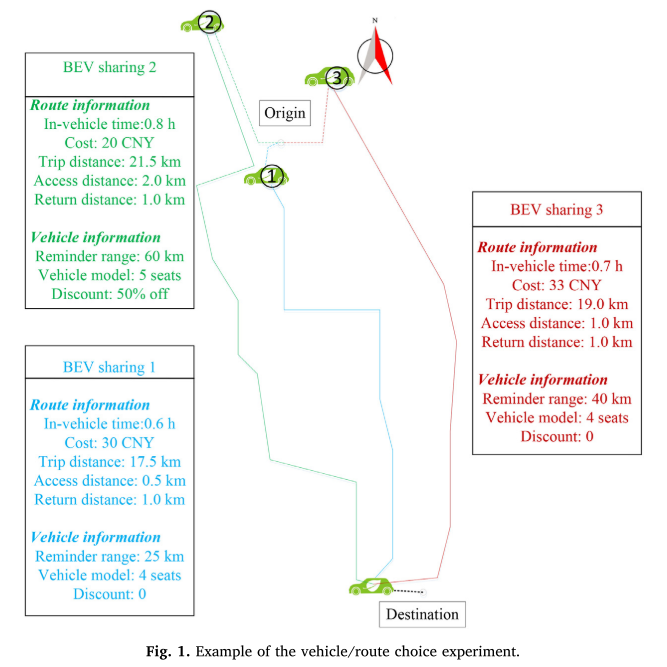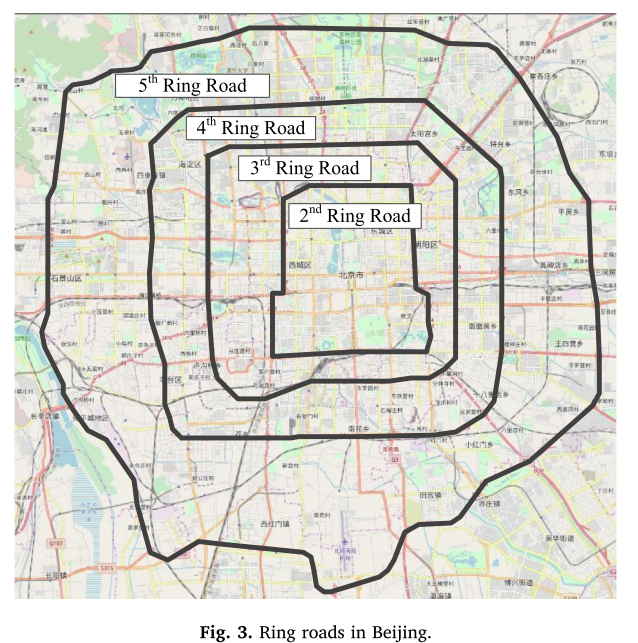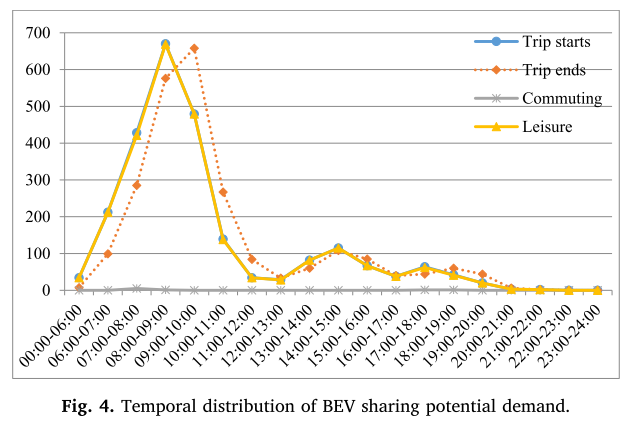Analysis of the potential demand for battery electric vehicle sharing: Mode share and spatiotemporal distribution

论文题目:Analysis of the potential demand for battery electric vehicle sharing: Mode share and spatiotemporal distribution
论文作者:金方磊,姚恩建,安琨
论文期刊:Journal of Transport Geography
网址:https://linkinghub.elsevier.com/retrieve/pii/S0966692319305149
关键词:共享汽车,纯电动汽车,共享模式,Nested Logit模型,潜在需求(Carsharing, Battery electric vehicle, Mode share, Nested logit model, Potential demand)
1摘要
共享汽车被认为是解决城市交通问题的方法之一。作为中国城市交通系统的一种新模式,共享汽车的表现以及其带来的影响仍然存在一些初步的问题。因此,本研究以纯电动共享汽车为研究对象调查其潜在需求,并以北京市为例进行研究。本研究通过建立Nested Logit模型并校正,以此分析出行者选择行为。此外,利用真实出行数据评估纯电动共享汽车的潜在需求,分析了潜在需求的时空分布、纯电动共享汽车对出行分担率的影响以及定价策略的影响。结果表明:当出行者与共享汽车站点间的平均距离为500米时,纯电动共享汽车的乐观出行分担率(optimistic mode split )为4.23%。纯电动共享汽车潜在需求的主要来源是公共交通,对私家车的替代效应较弱。出行者潜在出行集中在早高峰时段,主要从居住区或综合区(integrative areas)开始,到商业区或绿地结束。通勤和长距离出行对价格下降更为敏感,这将导致出行者使用纯电动共享汽车出行意愿增强。价格下调也可能增加晚高峰期间的潜在出行比例。这些发现对政府和经营者实施共享汽车站点规划、搬迁和定价策略等政策具有参考价值。
2研究背景
共享汽车被认为是解决空气污染和停车压力等城市交通问题的方法之一。共享汽车为出行者提供了一种可在短时间内使用的灵活汽车租赁服务,并根据出行时间和距离收取费用。共享汽车将昂贵的购置、保险、维修等固定拥有成本转化为可变成本,使用户能够灵活地满足自己的车辆需求。
目前有两种类型的共享汽车服务:往返式(round-trip)和单程式(one-way)。往返式要求使用者在出行结束时将车辆驶回出发地,单程式不要求使用者将车辆驶回出发地。目前在研究城市交通背景下的单程式共享汽车需求方面存在挑战。一方面,在城市交通系统中对单程式共享汽车的研究较少。另一方面,很少有研究对共享汽车需求的时空分布进行分析。
本研究基于SP调查和第五次北京市家庭出行调查,通过评估基于站点的单程式纯电动共享汽车( station-based one-way BEV sharing)潜在需求,分析了中国共享汽车系统特征。
3案例研究
3.1建立选择模型
本研究于2018年7 至8月间在北京开展了一项SP调查,收集在城市交通系统中纯电动共享汽车的选择数据。共发放问卷近600份,最终回收问卷536份,回复率为89.3%。在对缺失值或逻辑错误进行验证后,收集了512个样本和8689个选择结果。

为获取出行者选择偏好,采用了Nested Logit模型,其中车辆、路线选择也被纳入其中。上层的四个巢包括公共交通、出租车、私家车和纯电动共享汽车。在每个巢中,车辆或路线都设计在较低的层。由于在模型估计中使用了受访者的重复选择,本研究在效用函数中添加了误差分量,以处理由序列相关(也称为面板效应)引起的偏差。在四个巢中设置了四个误差分量,它们被设定为平均值为零且标准差有待估计的正态分布的形式。同样,如果被调查者没有私家车,则私家车将从对应的备选集合中移除。本研究在模型效用函数中考虑了共享汽车服务水平(level of service,简称 LOS)变量、出行场景变量和个人属性变量。

3.3潜在需求估计
使用基于真实出行数据估计的模型来估计潜在需求。真实出行数据来源于2014年第五次北京家庭出行调查,该调查在工作日进行,涉及40003个家庭,成员101815人,人口抽样率为0.52%。在调查中,每个受访者需要记录每天的出行情况,并提供详细的信息,如起止时间、出发地和目的地、出行方式、出行距离、出行目的、出行成本以及部分个人属性。研究范围为北京市五环路内。出行者是否会从原本出行方式向纯电动共享汽车转移,可以通过Nested Logit模型中的效用函数来估计。本研究遵循最大效用理论的基本假设——人们倾向于选择提供最大效用的方案。假设受访者所填写的每一次出行记录已经是所有现有方案中效用最大的选择。如果纯电动共享汽车的效用高于出行记录,则将该出行标记为潜在的共享纯电动汽车出行。


4研究结果
4.1出行行为分析
从模型标定结果看,大多数t值绝对值大于1.96,表明变量在95%的置信水平下具有统计学显著性。调整后的 McFadden's R squared为0.249,表明拟合优度极好。
(1)取车地点距离和还车地点距离(access distance and egress distance)对模式选择有负面影响。出行者更关心的是起点到共享汽车站点距离。
(2)富余里程(remaining range,即车辆剩余电量所能支持行驶里程减去本次出行行驶里程)对纯电动共享汽车选择有正向影响,说明剩余距离越大,出行者选择纯电动共享汽车可能性越大。
(3)出行者更喜欢五座车而不喜欢四座车。
(4)随着出行距离的增加,出行者使用纯电动共享汽车的出行意愿增加。

4.2潜在需求分析
1.表6展示了潜在纯电动共享汽车出行特征分布。
(1)对于潜在需求而言,纯电动共享汽车对减少私家车使用的潜力不大,共享汽车可能主要吸引来自公共交通的出行需求,这可能无助于改善交通条件。
(2)对于与出行目的相关的出行方式转变来看,休闲出行更倾向于使用纯电动共享汽车。说明在良好的共享汽车站点覆盖率和当前定价下,纯电动汽车共享主要吸引10公里以内的出行人群。
(3)不同共享汽车站点覆盖率的对比结果表明,公共交通用户在使用纯电动共享汽车时,对取车地点和还车地点的距离比较敏感。如果出行距离不够长,出行者可能无法容忍1公里的取车地点和还车地点距离。

2.图4显示出行开始和结束的时间分布。
不同时段的潜在需求差异较大,意味着不同共享汽车站点之间停放车辆数量存在很大的不平衡,纯电动共享汽车需求的时间分布在很大程度上取决于休闲出行总量的分布。因此共享电动汽车的潜在需求很可能出现在北京的早高峰。

3.图5显示了出行时间分布的比例。
将纯电动共享汽车的出行分布与总出行分布进行了比较。纯电动共享汽车在非高峰时间的出行比例更高,这说明从时间上看出行者倾向于在非高峰时段使用纯电动汽车共享。

4.潜在需求空间分布如图6所示。
每个点的大小表示潜在出行次数。在每个区域中出行开始和结束在各自对应的中心处聚合。出行开始和结束的不同分布显示了需求的不平衡,这可能会在纯电动共享汽车车辆转移方面带来大量的工作。

5.图7模拟了定价变化对交通方式分担率( mode split)和总收益的影响。
当价格下降时,交通方式分担率增加。

6.表7显示了原始出行方式、出行目的和出行距离对价格变化的敏感性。
(1)非公共交通出行者对折扣更为敏感。
(2)盲目降低价格可能会导致从公共交通系统转向道路交通系统的巨大需求,因为纯电动共享汽车吸引的出行大部分是公共交通出行。
(3)通勤者更容易受到价格的影响。
(4)长途出行更有可能受到激励措施的吸引。

7.图8显示价格变化对行程开始时间的影响。
当价格降低时,通勤出行对价格更加敏感,具有使用纯电动共享汽车的潜力。同时,折扣策略对出行起始时间分布也有影响。对于运营商来说,可以采用折扣策略,如在晚高峰时段增加使用率以使利润增加。

5研究结论
本研究以城市交通系统中基于站点的单程式纯电动共享汽车为研究对象,通过出行方式选择行为分析,研究其潜在需求。研究结果表明:(1)良好的服务覆盖率对实现纯电动共享汽车共享模式具有重要意义。(2)纯电动共享汽车替代私家车的效果较弱。(3)非高峰时段纯电动共享汽车的使用比例较高。(4)在价格敏感性方面,当纯电动共享汽车价格下降时,通勤出行和长距离出行者更容易被吸引。
6参考文献
Balac, M., Ciari, F., Axhausen, K.W., 2015. Carsharing demand estimation Zurich, Switzerland, area case study. Transp. Res. Rec. 2536, 10–18.
Becker, H., Loder, A., Schmid, B., Axhausen, K.W., 2017. Modeling car-sharing mem- bership as a mobility tool: a multivariate Probit approach with latent variables. Travel Behav.Soc. 8, 26–36.
Beijing Shouqi Easy Go Technology Co. Ltd, 2019. Available from: https://www. shouqiev.com/index.html Accessed June 2019.
Boldrini, C., Bruno, R., Conti, M., 2016. Characterising Demand and Usage Patterns in a Large Station-Based Car Sharing System. Computer Communications Workshops. IEEE.
Buehler, R., 2011. Determinants of transport mode choice: a comparison of Germany and the Usa. J. Transp. Geogr. 19 (4), 0–657.
Ceccato, R., Diana, M., 2018. Transportation. https://doi.org/10.1007/s11116-018- 9901-8.
Cervero, R., Tsai, Y., 2004. City carshare in San Francisco, California: second-year travel demand and car ownership impacts. Transport. Res. Record J. Transport. Res. Board 1887 (1), 117–127.
Chen, T., Kockelman, K., Khan, M., 2014. Locating electric vehicle charging stations. Trans. Res. Rec. J. Trans. Res. Board 2385 (2385), 28–36.
Ciari, F., Schuessler, N., Axhausen, K.W., 2013. Estimation of carsharing demand using an activity-based microsimulation approach: model discussion and some results. Int. J. Sustain. Transp. 7 (1), 70–84.
Coll, M.H., Vandersmissen, M.H., Thériault, M., 2014. Modeling spatio-temporal diffusion of carsharing membership in Québec City. J. Transp. Geogr. 38, 22–37.
de Almeida Correia, G.H., Antunes, A.P., 2012. Optimization approach to depot location and trip selection in one-way carsharing systems. Transport. Res E: Logist. Transport. Rev. 48 (1), 233–247.
De Luca, S., Di Pace, R., 2015. Modelling users’ behaviour in inter-urban carsharing program: a stated preference approach. Transp. Res. A Policy Pract. 71, 59–76.
Dong, J., Liu, C., Lin, Z., 2014. Charging infrastructure planning for promoting battery electric vehicles: an activity-based approach using multiday travel data. Transp. Res. C 38 (1), 44–55.
Efthymiou, D., Antoniou, C., Waddell, P., 2013. Factors affecting the adoption of vehicle sharing systems by young drivers. Transp. Policy 29, 64–73.
Egbue, O., Long, S., 2012. Barriers to widespread adoption of electric vehicles: an analysis of consumer attitudes and perceptions. Energy Policy 48 (3), 717–729.
Heilig, M., Mallig, N., Schröder, O., Kagerbauer, M., Vortisch, P., 2017. Implementation of free-floating and station-based carsharing in an agent-based travel demand model. Travel Behav.Soc. 12, 151–158 S2214367X16300722.
Hess, S., Rose, J.M., 2009. Allowing for intra-respondent variations in coefficients esti- mated on repeated choice data. Transp. Res. B Methodol. 43 (6), 0–719.
Hu, L., Dong, J., Lin, Z., Yang, J., 2018. Analyzing battery electric vehicle feasibility from taxi travel patterns: the case study of new York City, USA. Trans. Res. Part C: Emerg. Technol. 87, 91–104.
Hua, C., Jia, X., Chiu, A.S.F., Hu, X., Ming, X., 2014. Siting public electric vehicle char- ging stations in Beijing using big-data informed travel patterns of the taxi fleet. Transp. Res. D 33, 39–46.
Huang, K., de Almeida Correia, G.H., An, K., 2018. Solving the station-based one-way carsharing network planning problem with relocations and non-linear demand. Trans. Res. Part C: Emerg. Technol. 90, 1–17.
Hui, Y., Wang, W., Ding, M., Liu, Y., 2017a. Behavior patterns of long-term car-sharing users in China. Trans. Res. Procedia 25, 4662–4678.
Hui, Y., Ding, M., Zheng, K., Lou, D., 2017b. Observing trip chain characteristics of round- trip carsharing users in China: a case study based on GPS data in Hangzhou city. Sustainability 9 (6), 949.
Jorge, D., Correia, G.H., Barnhart, C., 2014. Comparing optimal relocation operations with simulated relocation policies in one-way carsharing systems. IEEE Trans. Intell. Transp. Syst. 15 (4), 1667–1675.
Kato, H., Inagi, A., Igo, T., 2012. Awareness and potential choices of carsharing: Comparative analysis of data from four Japanese cities. In: Proceedings of the 91st Annual Meeting of the Transportation Research Board, Washington, DC (CD-ROM).
Kim, K., 2015. Can carsharing meet the mobility needs for the low-income neighbor- hoods? Lessons from carsharing usage patterns in New York City. Transp. Res. A Policy Pract. 77, 249–260.
Kim, D., Ko, J., Park, Y., 2015. Factors affecting electric vehicle sharing program parti- cipants’ attitudes about car ownership and program participation. Transp. Res. Part D: Transp. Environ. 36, 96–106.
Kortum, K., 2014. Driving smart: Carsharing mode splits and trip frequencies. In: Transportation Research Board 93rd Annual Meeting (No. 14–4009).
Le Vine, S., Lee-Gosselin, M., Sivakumar, A., Polak, J., 2014. A new approach to predict the market and impacts of round-trip and point-to-point carsharing systems: case study of London. Transp. Res. Part D: Transp. Environ. 32, 218–229.
Martin, E.W., Shaheen, S.A., 2011. Greenhouse gas emission impacts of carsharing in North America. IEEE Trans. Intell. Transp. Syst. 12 (4), 1074–1086.
Martin, E.W., Shaheen, S.A., 2014. Evaluating public transit modal shift dynamics in response to bikesharing: a tale of two u.s. cities. J. Transp. Geogr. 41, 315–324.
Martin, E., Shaheen, S.A., Lidicker, J., 2010. Impact of carsharing on household vehicle holdings. Transport. Res. Rec.: J. Trans. Res. Board 2143 (1), 150–158.
Martínez, L.M., Correia, G.H.D.A., Moura, F., Mendes Lopes, M., 2017. Insights into carsharing demand dynamics: outputs of an agent-based model application to Lisbon, Portugal. Int. J. Sustain. Transp. 11 (2), 148–159.
Namdeo, A., Tiwary, A., Dziurla, R., 2014. Spatial planning of public charging points using multi-dimensional analysis of early adopters of electric vehicles for a city re- gion. Technol. Forecast. Soc. Change 89, 188–200.
Neubauer, J., Brooker, A., Wood, E., 2012. Sensitivity of battery electric vehicle eco- nomics to drive patterns, vehicle range and charge strategies. J. Power Sources 209 (7), 269–277.
Rabbitt, N., Ghosh, B., 2013. A study of feasibility and potential benefits of organised car sharing in Ireland. Transp. Res. Part D: Transp. Environ. 25, 49–58.
Rotaris, L., Danielis, R., 2018. The role for carsharing in medium to small-sized towns and in less-densely populated rural areas. Transp. Res. A Policy Pract. 115, 49–62.
Santos, G.G.D., de Almeida Correia, G.H., 2019. Finding the relevance of staff-based vehicle relocations in one-way carsharing systems through the use of a simulation- based optimization tool. J. Intell. Transp. Syst. 1–22.
Schmöller, S., Bogenberger, K., 2014. Analyzing external factors on the spatial and temporal demand of car sharing systems. Procedia Soc. Behav. Sci. 111, 8–17.
Schmöller, S., Weikl, S., Müller, J., Bogenberger, K., 2015. Empirical analysis of free- floating carsharing usage: the Munich and Berlin case. Trans. Res. Part C: Emerg. Technol. 56, 34–51.
Shaheen, S., Martin, E., 2006. Assessing Early Market Potential for Carsharing in China: A Case Study of. University of California, Beijing.
Shaheen, S., Cohen, A., Roberts, J.D., 2006. Carsharing in North America: market growth, current developments, and future potential. J. Transp. Res. Board 1986, 116–124.
Shaheen, S.A., Chan, N.D., Micheaux, H., 2015. One-way carsharing’s evolution and operator perspectives from the Americas. Transportation 42 (3), 519–536.
Sohu, 2017. Carsharing is coming! Beijing improves the network of carsharing. In: There Will Be 2000 Vehicles till the End of the Year, . http://www.sohu.com/a/ 128882487_492534.
Sohu, 2018. Xiaoyua Wu: Carsharing in China Has Become The First Place In Globe, Electric Vehicles Take Up 90% Of The Shared Vehicles. https://www.sohu.com/a/ 218117563_436027.
Stasko, T.H., Buck, A.B., Gao, H.O., 2013. Carsharing in a university setting: impacts on vehicle ownership, parking demand, and mobility in Ithaca. Ny. Trans. Policy 30 (4), 262–268.
Steininger, K.W., Bachner, G., 2014. Extending car-sharing to serve commuters: an im- plementation in Austria. Ecol. Econ. 101, 64–66.
Vasconcelos, A.S., Martinez, L.M., Correia, G.H., Guimarães, D.C., Farias, T.L., 2017. Environmental and financial impacts of adopting alternative vehicle technologies and relocation strategies in station-based one-way carsharing: an application in the city of Lisbon, Portugal. Transp. Res. Part D: Transp. Environ. 57, 350–362.
Wang, M., Martin, E.W., Shaheen, S.A., 2012. Carsharing in Shanghai, China: analysis of behavioral response to local survey and potential competition. Transp. Res. Rec. 2319 (1), 86–95.
Wang, Y., Yan, X., Zhou, Y., Xue, Q., Sun, L., 2017. Individuals’ acceptance to free-floating electric carsharing mode: a web-based survey in China. Int. J. Environ. Res. Public Health 14 (5), 476.
Washbrook, K., Haider, W., Jaccard, M., 2006. Estimating commuter mode choice: a discrete choice analysis of the impact of road pricing and parking charges. Transportation 33 (6), 621–639.
Yoon, T., Cherry, C.R., Jones, L.R., 2017. One-way and round-trip carsharing: a stated preference experiment in Beijing. Transp. Res. Part D: Transp. Environ. 53, 102–114.
Zhang, R., Yao, E., Liu, Z., 2017. School travel mode choice in Beijing, China. J. Transp.Geogr. 62, 98–110.
Zhou, B., Kockelman, K.M., 2011. Opportunities for and impacts of carsharing: a survey of the Austin, Texas market. Int. J. Sustain. Transp. 5 (3), 135–152.
Zoepf, S.M., Keith, D.R., 2016. User decision-making and technology choices in the US carsharing market. Transp. Policy 51, 150–157.